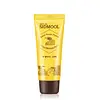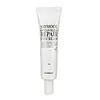What's inside
What's inside
 Key Ingredients
Key Ingredients

 Benefits
Benefits

 Concerns
Concerns

No concerns
 Ingredients Side-by-side
Ingredients Side-by-side

Honey Extract 40%
HumectantWater
Skin ConditioningAloe Barbadensis Leaf Juice
Skin ConditioningGlycerin
HumectantGlycereth-26
HumectantHyaluronic Acid
HumectantSorbitol
HumectantPropolis Extract
Skin ConditioningRoyal Jelly Extract
Skin ConditioningSh-Oligopeptide-1
Skin ConditioningSh-Polypeptide-11
Oligopeptide-2
Skin ConditioningHydrolyzed Collagen
EmollientBeta-Glucan
Skin ConditioningPortulaca Oleracea Extract
Skin ConditioningOriganum Vulgare Leaf Extract
Skin ConditioningCaffeoyl Tripeptide-1
AntioxidantChamomilla Recutita Flower Extract
MaskingGlycine Max Seed Extract
Skin ConditioningScutellaria Baicalensis Root Extract
AstringentButylene Glycol
HumectantSucrose
HumectantFructose
HumectantGlucose
HumectantTrehalose
HumectantPanthenol
Skin ConditioningDipotassium Glycyrrhizate
HumectantAllantoin
Skin ConditioningGlucosylrutin
AntioxidantArginine
MaskingCarbomer
Emulsion StabilisingXanthan Gum
Emulsifying1,2-Hexanediol
Skin ConditioningHoney Extract 40%, Water, Aloe Barbadensis Leaf Juice, Glycerin, Glycereth-26, Hyaluronic Acid, Sorbitol, Propolis Extract, Royal Jelly Extract, Sh-Oligopeptide-1, Sh-Polypeptide-11, Oligopeptide-2, Hydrolyzed Collagen, Beta-Glucan, Portulaca Oleracea Extract, Origanum Vulgare Leaf Extract, Caffeoyl Tripeptide-1, Chamomilla Recutita Flower Extract, Glycine Max Seed Extract, Scutellaria Baicalensis Root Extract, Butylene Glycol, Sucrose, Fructose, Glucose, Trehalose, Panthenol, Dipotassium Glycyrrhizate, Allantoin, Glucosylrutin, Arginine, Carbomer, Xanthan Gum, 1,2-Hexanediol
Ginkgo Biloba Leaf Water 43%
MaskingWater
Skin ConditioningGlycerin
HumectantHelianthus Annuus Seed Oil
EmollientCetearyl Alcohol
EmollientNiacinamide
Smoothing1,2-Hexanediol
Skin ConditioningButylene Glycol
HumectantSodium Hyaluronate
HumectantPolyglutamic Acid
Skin ConditioningCollybia Mushroom Extract
Hydrolyzed Collagen
EmollientSimmondsia Chinensis Seed Oil
EmollientOlea Europaea Fruit Oil
MaskingLysolecithin
EmulsifyingSh-Oligopeptide-1 2%
Skin ConditioningAcetyl Hexapeptide-8
HumectantHydrogenated Polydecene
EmollientRosa Rugosa Callus Culture Extract
AntimicrobialPropolis Extract
Skin ConditioningCaviar Extract
Skin ConditioningSophora Japonica Root Extract
Skin ProtectingPunica Granatum Extract
AstringentMaranta Arundinacea Root Extract
SmoothingInula Racemosa Root Extract
Skin ConditioningFicus Carica Fruit Extract
HumectantMorus Alba Fruit Extract
AntioxidantButyrospermum Parkii Butter
Skin ConditioningGinkgo Biloba Leaf Extract
Skin ConditioningEthylhexylglycerin
Skin ConditioningAllantoin
Skin ConditioningAdenosine
Skin ConditioningCarbomer
Emulsion StabilisingArginine
MaskingGinkgo Biloba Leaf Water 43%, Water, Glycerin, Helianthus Annuus Seed Oil, Cetearyl Alcohol, Niacinamide, 1,2-Hexanediol, Butylene Glycol, Sodium Hyaluronate, Polyglutamic Acid, Collybia Mushroom Extract, Hydrolyzed Collagen, Simmondsia Chinensis Seed Oil, Olea Europaea Fruit Oil, Lysolecithin, Sh-Oligopeptide-1 2%, Acetyl Hexapeptide-8, Hydrogenated Polydecene, Rosa Rugosa Callus Culture Extract, Propolis Extract, Caviar Extract, Sophora Japonica Root Extract, Punica Granatum Extract, Maranta Arundinacea Root Extract, Inula Racemosa Root Extract, Ficus Carica Fruit Extract, Morus Alba Fruit Extract, Butyrospermum Parkii Butter, Ginkgo Biloba Leaf Extract, Ethylhexylglycerin, Allantoin, Adenosine, Carbomer, Arginine
 Reviews
Reviews

Ingredients Explained
These ingredients are found in both products.
Ingredients higher up in an ingredient list are typically present in a larger amount.
1,2-Hexanediol is a synthetic liquid and another multi-functional powerhouse.
It is a:
- Humectant, drawing moisture into the skin
- Emollient, helping to soften skin
- Solvent, dispersing and stabilizing formulas
- Preservative booster, enhancing the antimicrobial activity of other preservatives
Allantoin is a soothing ingredient known for its protective and moisturizingg properties. Because of this, it is often added to products with strong active ingredients.
Studies show higher concentrations of this ingredient can promote wound healing.
Though it can be derived from the comfrey plant, allantoin is produced synthetically for cosmetic products to ensure purity.
Learn more about AllantoinArginine is an amino acid that is important for human development. Your body uses is it to produce hair keratin and skin collagen.
As a cosmetic ingredient, Arginine has antioxidant properties and can also help repair damaged skin. This ingredient is derived either synthetically or from animals.
Arginine isn't fungal acne safe when used in the presence of other lipids (fats, fatty acids, oils, esters, etc). Oils and fats occur naturally within the skin, so take caution when using Arginine if you're prone to fungal acne.
Learn more about ArginineButylene Glycol (or BG) is used within cosmetic products for a few different reasons:
Overall, Butylene Glycol is a safe and well-rounded ingredient that works well with other ingredients.
Though this ingredient works well with most skin types, some people with sensitive skin may experience a reaction such as allergic rashes, closed comedones, or itchiness.
Learn more about Butylene GlycolCarbomer is a polymer of acrylic acid. Its main role is to create a gel consistency.
A high amount of carbomer can cause pilling or balling up of products. Don't worry, most products contain 1% or less of carbomer.
Glycerin is already naturally found in your skin. It helps moisturize and protect your skin.
A study from 2016 found glycerin to be more effective as a humectant than AHAs and hyaluronic acid.
As a humectant, it helps the skin stay hydrated by pulling moisture to your skin. The low molecular weight of glycerin allows it to pull moisture into the deeper layers of your skin.
Hydrated skin improves your skin barrier; Your skin barrier helps protect against irritants and bacteria.
Glycerin has also been found to have antimicrobial and antiviral properties. Due to these properties, glycerin is often used in wound and burn treatments.
In cosmetics, glycerin is usually derived from plants such as soybean or palm. However, it can also be sourced from animals, such as tallow or animal fat.
This ingredient is organic, colorless, odorless, and non-toxic.
Glycerin is the name for this ingredient in American English. British English uses Glycerol/Glycerine.
Learn more about GlycerinHydrolyzed collagen has a misleading name because it is actually a mixture of various proteins/peptides. This ingredient has skin hydrating properties.
Collagen is the most abundant type of structural protein found in your body. In your skin, it is responsible for keeping it firm and youthful.
Hydrolyzed Collagen is created by breaking up proteins into smaller peptide bonds. These peptides act as humectants and emollients.
Humectants are great at holding onto water, keeping skin hydrated. Emollients create a thin barrier on the skin to prevent moisture from escaping.
There is ongoing debate about whether hydrolyzed collagen works because it increases skin hydration. Skin hydration is also linked to elasticity and the appearance of wrinkles.
Collagen or peptide ingredients can be used in the morning or night. They will not increase sun sensitivity, but you should always wear sunscreen during the day.
According to a manufacturer, this ingredient is a great hair conditioner as well.
This ingredient can be extracted from different sources, including:
Vegan collagen is derived from yeast, bacteria, or plant sources. Vegan collagen would go by a different INCI name, such as hydrolyzed soy protein.
The results are varied.
A study from 2021 found hydrolyzed collagen increased elasticity and improved wrinkles in 1,125 participants between age 20 and 70. Another study found increased skin thickness in participants between the ages of 45 to 59.
However, It is difficult to prove that oral collagen will end up working on your skin. Many of the studies using hydrolyzed collagen also add several vitamins and nutrients into the test mixture as well.
Further studies are needed at this time.
Learn more about Hydrolyzed CollagenPropolis Extract is also known as bee glue.
This ingredient has antimicrobial, anti-inflammatory, wound healing, and antioxidant properties.
Studies show propolis helps fight against bacteria, viruses, and fungi. This may help with reducing acne and accelerate wound healing.
The flavonoids found in propolis extract are potent antioxidants. Antioxidants may help with reducing the signs of aging.
A study from 2020 found propolis to help reverse skin damage from UV.
Fun facts: This ingredient is created by mixing beeswax, bee saliva, and parts of trees. Bees use propolis as a sealant to close any gaps in their hives.
Since it is an animal-derived product, this ingredient is not considered vegan. For vegan alternatives, check out Galactomyces Ferment Filtrate or Centella Asiatica Extract.
Learn more about Propolis Extractsh-Oligopeptide-1 is a peptide found naturally in our bodies. Peptides are the building blocks for collagen and elastin in our skin.
In cosmetics, this ingredient is bioengineered to be identical to a human gene that codes for epidermal growth factor (EGF). EGF are signal molecules that simulate cell growth and healing.
Studies find EGF help with:
In South Korea and China, EGF is considered a controversial ingredient. The South Korean Ministry of Food and Drug Safety has cracked down on companies with products including EGF due to false advertisement claims.
According to Dr. Zoe Draelos, growth factors have some drawbacks:
There is also controversy surrounding growth factors. The controversy is due to their mitogenic activity, or their ability to increase the number of cells. It is best to avoid using growth factors if you have psoriasis or are at risk of skin cancer. However, it should be noted EGF are not mutagenic - meaning they will not cause cancer.
Learn more about Sh-Oligopeptide-1Water. It's the most common cosmetic ingredient of all. You'll usually see it at the top of ingredient lists, meaning that it makes up the largest part of the product.
So why is it so popular? Water most often acts as a solvent - this means that it helps dissolve other ingredients into the formulation.
You'll also recognize water as that liquid we all need to stay alive. If you see this, drink a glass of water. Stay hydrated!
Learn more about Water